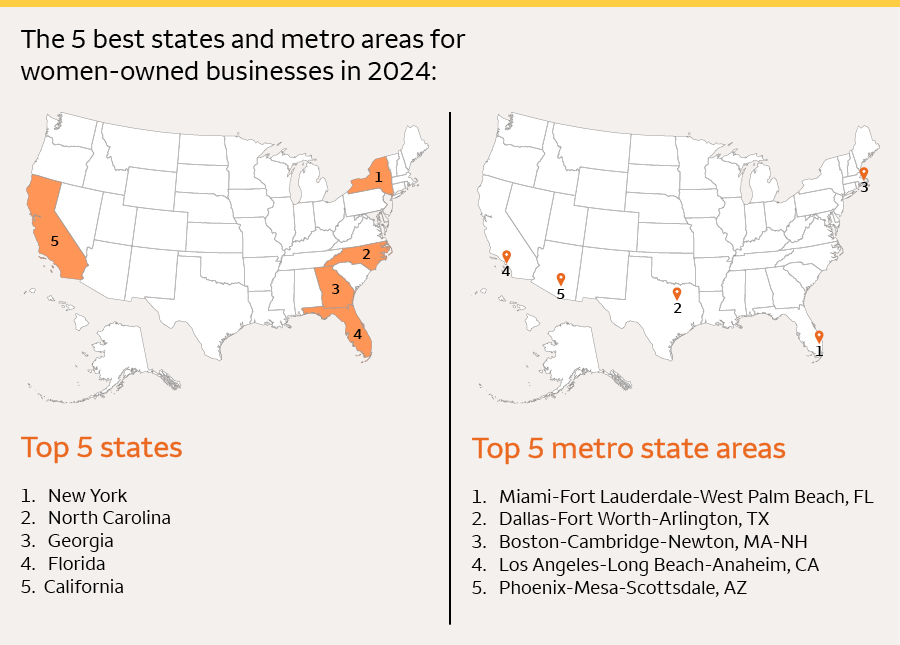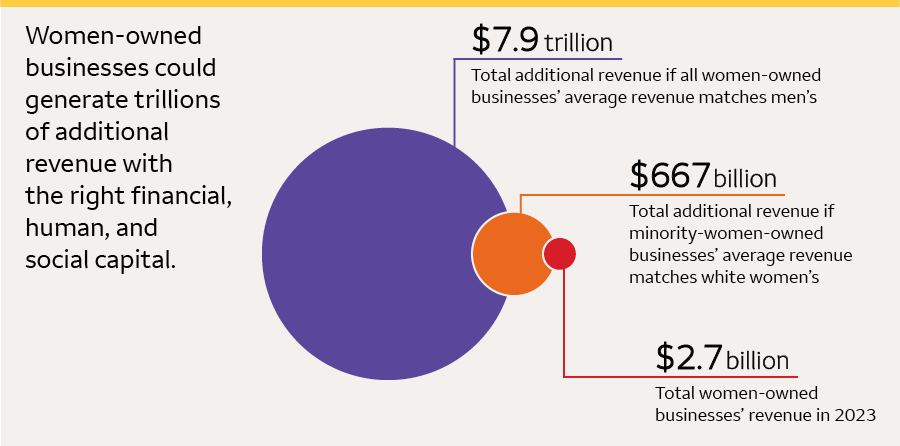Women-owned businesses are driving economic growth. Here’s what entrepreneurs should know.
A new landscape for women-owned businesses has begun to appear over the past few years. They’re forming, increasing revenue, and employing more people faster than men-owned businesses, according to a Wells Fargo report. What’s changed?

It’s an unprecedented time for women business owners. A Wells Fargo report reveals women-owned businesses aren’t just growing in number, but growing faster than those of their male counterparts, too. Even with COVID-19 challenges, women are increasingly taking the leap into running their own business, and the economy is changing as a result.
Why are more of these entrepreneurs achieving success? Here’s what you need to know from the 2024 Impact of Women-Owned Businesses report (PDF) from Wells Fargo.
1. Women-owned businesses’ growth is fueled in part by increased support
The pandemic years saw huge investments in support for small businesses, which is one reason more women entrepreneurs are starting or growing businesses. Especially throughout the Paycheck Protection Program (PPP), banks and community development financial institutions (CDFIs) helped entrepreneurs — women and minority business owners, in particular — through tough times. Often, CDFIs, which received an unprecedented level of philanthropic funds, offered these businesses flexible capital, grants, and loan aid.
“We saw corporations like Wells Fargo and other community organizations coming together and rallying to support these women to make sure that not only were they supporting these businesses, but they were going to have an ecosystem that allowed them to grow and sustain that business,” said Val Jones, Wells Fargo Women’s Segment Lead for Small Business.
This support also came at more local levels. The report shows what metros and states were home to growing women-owned businesses (see graphic below).

A common denominator among these areas may be a healthy local economy, but Jones said many also went out of their way to lift up these businesses through supplier diversity programs, training, women’s business centers, funding or capital support.
2. Women are starting businesses out of necessity — and many are thriving
Necessity entrepreneurs are people who start a business when they lose a job or need to supplement their income. They’re more common during uncertain economic times like the pandemic. Typically, these nonemployers — enterprises without paid employees beyond an owner — like freelance, startup, or side businesses. Recessions tend to see more nonemployer businesses and fewer businesses with employees.
But recent years have bucked that trend. During this time, women opened both nonemployer and employer businesses in greater numbers, while growing revenue in both cases, too. In fact, women-owned businesses added 1.4 million jobs and generated $579.6 billion to the economy amid the pandemic, the report shows.
“What we found is a lot of women chose to start businesses during that time out of necessity,” Jones said, “but what’s exciting is not only that they started out of necessity, but they were also able to grow that.”

3. Businesses owned by women of color came out of the pandemic stronger compared with the 2008 financial crisis
The Great Recession that started in 2007 disproportionally hurt Hispanic/Latino and Black/African American women entrepreneurs. For example, while revenue among all women-owned business was down 6.3% on average in 2012 following the downturn, that number was nearly four times higher for Hispanic/Latino women business owners and five times higher for Black women business owners.
So far, that’s not been the case during the pandemic. In fact, businesses owned by women of color are performing better on average than they were pre-pandemic. Black/African American and Hispanic/Latino women grew their average revenue by 32.7% and 17.1% between 2019 and 2023, respectively.
“What that says is that these women are finding new ways to create wealth in their communities,” Jones said. “It’s exciting for the future of our economy that we have women in these communities starting businesses.”
4. Women are opening doors in more industries
Today, more than half of all women-owned business are part of just four industries: professional and technical services, administrative and support services, health care and social assistance, and personal care and beauty services.
That’s changing, the Wells Fargo report reveals. What sector saw the biggest change in new women-owned nonemployer businesses? The transportation and warehouse industry. The number of these entrepreneurs soared 51% during the pandemic. The other services category and education services also saw high growth.
Employer finance, insurance, and real estate firms also saw large jumps in business formations from women entrepreneurs.
The next question is how these businesses will grow in sectors that see relatively fewer women industry leaders.
“There is a huge opportunity here for women-owned businesses to take that growth and move from being small businesses to mid-market businesses where they can really add to the workforce and make a larger contribution to the economy,” said Judith Goldkrand Wells Fargo Women’s Segment Lead for Commercial Banking.

5. Gender gaps between business owners are still significant — but narrowing
While women entrepreneurs are becoming an increasingly larger part of the economy, there’s still ground to cover. Women-owned businesses made up nearly two in five U.S. businesses, yet only generated about 5.8% of total national firm revenue in 2023. A few reasons for this are that women-owned businesses are more likely to be in lower-revenue industries and women are more likely to be part-time or necessity entrepreneurs, according to the report.
But the potential for women-owned businesses is huge. If their average revenue matched that of businesses owned by men, that would generate nearly $8 trillion in revenue (see graphic above).
Progress is happening. The “difference-maker” is that more women-owned businesses are earning more revenue and adding more employees, which Jones said has a “tremendous impact” on the greater economy.
“Women absolutely have a bigger role in driving the economy,” she said. “As we see women-owned businesses not only grow in number, but in their ability to employ and grow their revenue, it’s a great sign for the small business community overall.”







